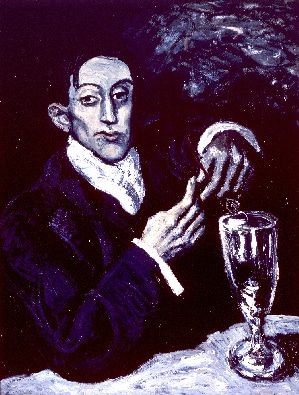He’s back! Four years and one lawsuit later, the angel has descended again. This portrait is, I’m convinced, the best Blue Period painting not yet in a museum, and one of the best of all. If I had a cool hundred mil to blow, I would have held my fire when the Marie-Therese was up last month and would have set my sights on him. She’s not the best Marie-Therese by a long shot, but she was available, and I suppose you gotta love the one you’re with. Or not.
The Portrait de Angel Fernandez de Soto is such a powerful work. I stood transfixed before it for quite a while four years ago and regret that I won’t be traveling to see it in London before it disappears once again. Back then, I predicted here that this painting would set a new world’s record. Never shy of walking out on a limb, I’ll do so again now. He may not be as colorful nor as sexy as the Marie-Therese, but lately the market has seemed pretty sophisticated and will hopefully value this painting appropriately.
What do I mean by “sophisticated”? Simply the ability of the buyer to look beyond size, color, and superficial “prettiness” to the real beauty (and importance) of the work. A good example of this is the 1933 smallish inkwash (22.6 x 28.7 cm, 8 7/7/8 x 11 1/4”) entitled Le repos du sculpteur that just sold at Sotheby’s Paris for 3,760,750 euro (4,572,311 USD), at about five times its high estimate I might add:
Christie’s has a long and excellent discussion of the Angel de Soto in its catalogue. The best part of it is arguably the quote from John Richardson, which I’ll reproduce here:
“The portraits that Picasso did of his closest friends, Angel de Soto and Sabartés, in the course of his last months in Barcelona delve far more deeply into character and take far greater liberties…. The deformations in the Soto portrait–the jug ear, skewed mouth, prognathous chin–seem caricatural, but the image transcends caricature. By this time Picasso had learned how to exploit his inherent gift for caricature in depth as a means of dramatizing psychological as well as physiognomic traits. Whereas the average caricaturist externalizes things and comes up with an image that is slick and trite–an instant cliché–Picasso internalizes things and comes up with an enhanced characterization of his subject. Picasso enlarges Angel’s heavy-lidded eyes out of all proportion and endows them with his own obsidian stare. Among his immediate predecessors, only van Gogh had this ability to galvanize a portrait with his own psychic energy.” (J. Richardson, A Life of Picasso: Volume I: 1881-1906, London, 1991, pp. 285-86).
Full disclosure: I have nothing to disclose. I only wish I were able to influence the course of the sale of this Blue Period masterpiece!

